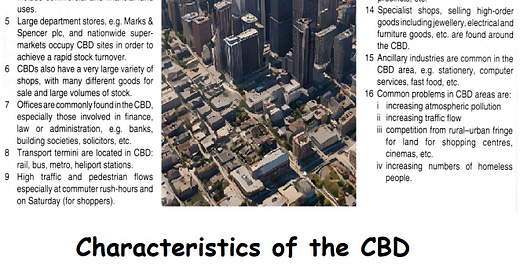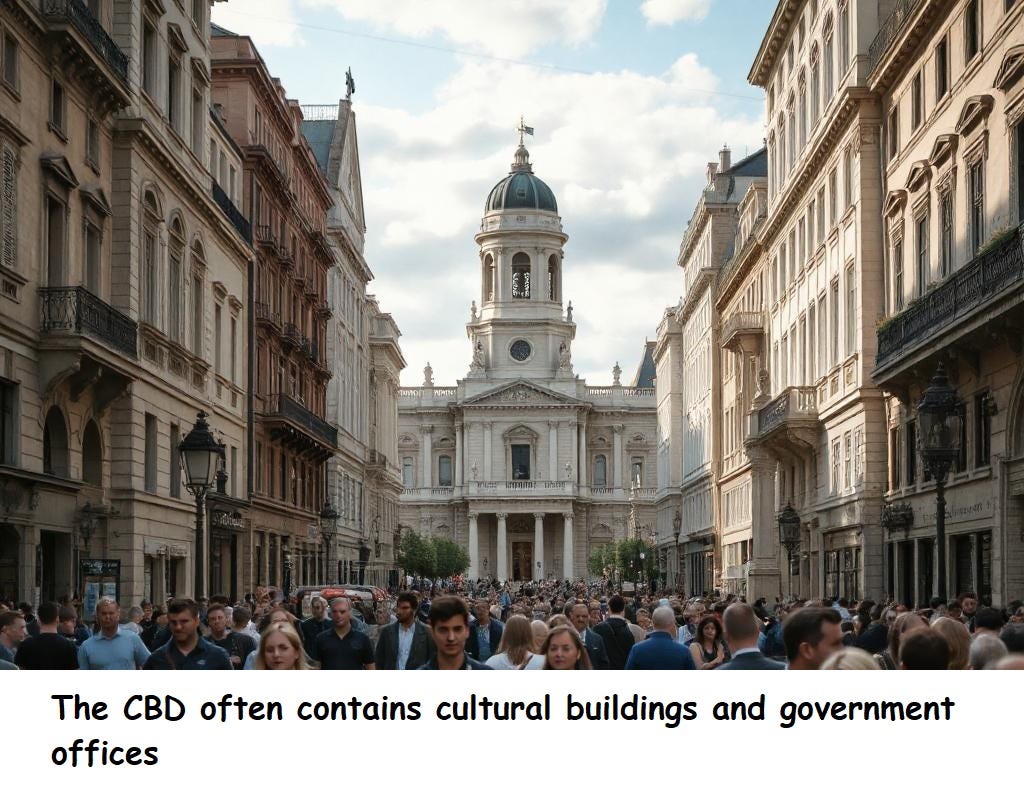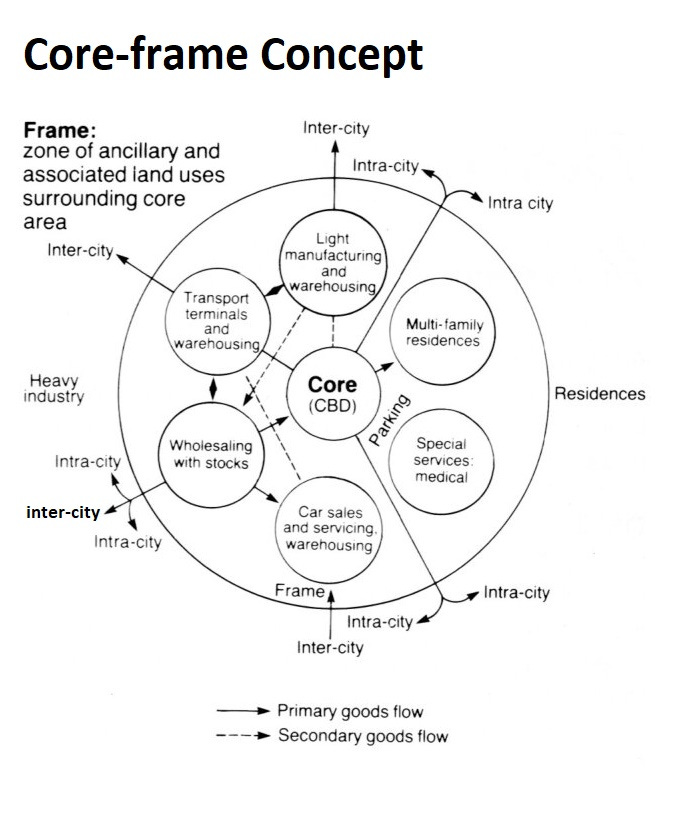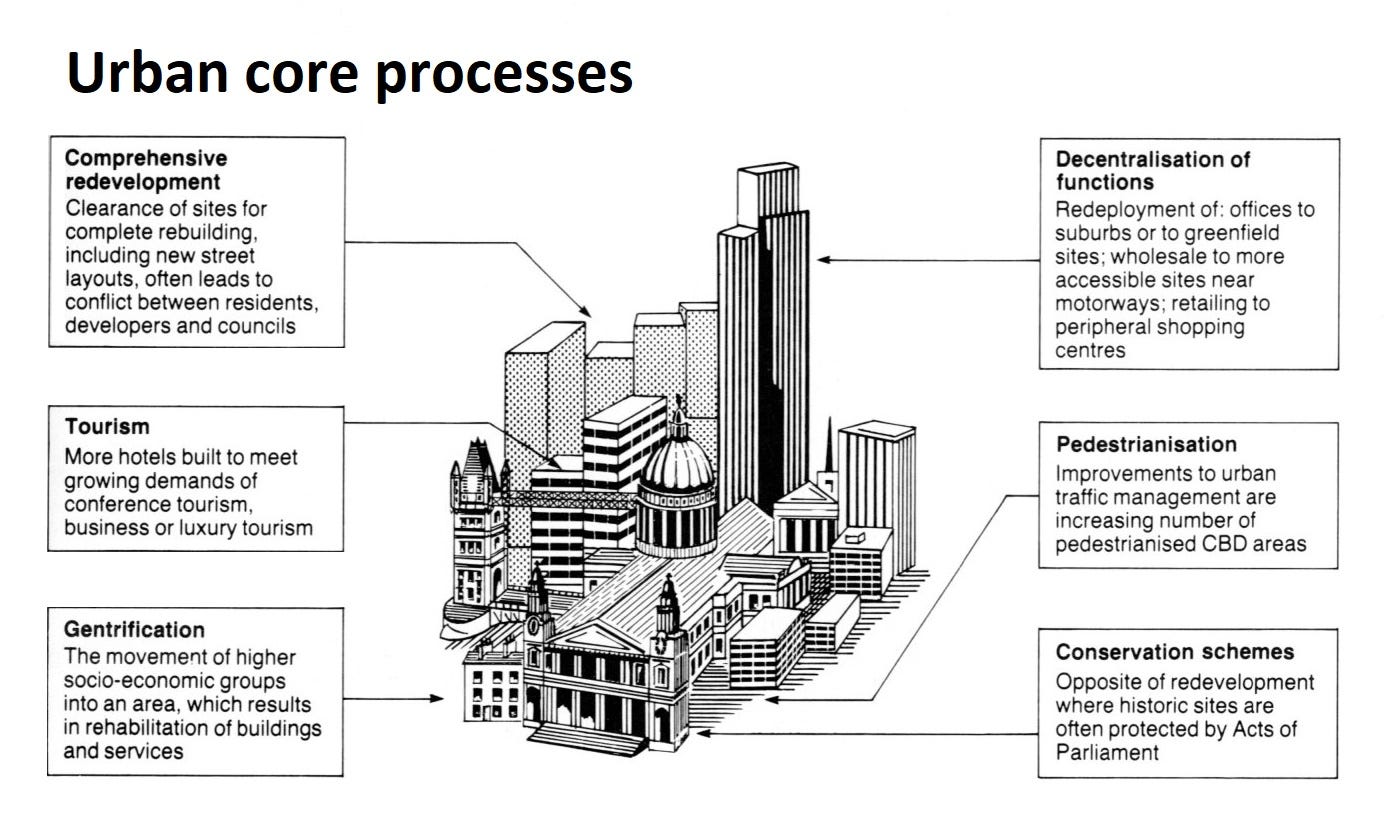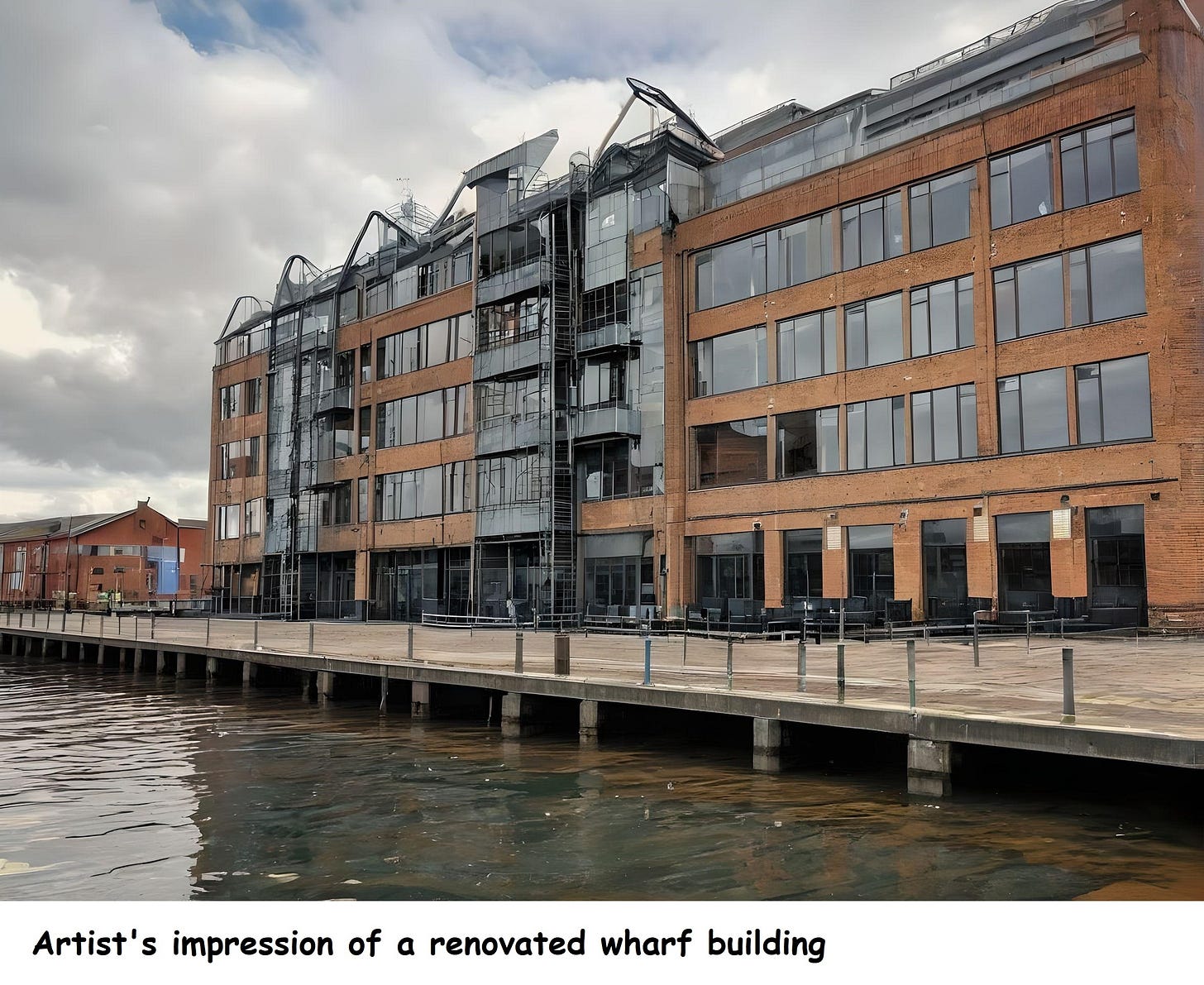The Central Business District, how it may be delineated and common characteristics
The Central Business District (CBD) is the core commercial and economic hub of a city. It is typically characterized by dense development, high land values, a concentration of businesses, financial institutions, government offices, cultural landmarks, and a significant amount of pedestrian and vehicular traffic. The delineation and characteristics of a CBD can vary from city to city, but there are common features that define this central area.
Delineation of a CBD: The delineation of a CBD is often defined through a combination of factors such as land use patterns, building densities, economic activities, transportation infrastructure, and historical significance. Some common methods used to delineate a CBD include:
Zoning Regulations: Cities may establish specific zoning regulations that designate certain areas as central business districts, outlining the permitted land uses and building densities.
Economic Activity: The concentration of commercial and financial activities, such as office buildings, retail establishments, and headquarters of major companies, can help define the boundaries of a CBD.
Physical Features: Landmarks, major intersections, or iconic buildings may serve as reference points to establish the boundaries of a CBD.
Historical Significance: In some cases, the historical development of a city can influence the delineation of the CBD, often centred around the original core of the city or areas of cultural and architectural significance.
Characteristics of a CBD: The CBD of a city typically exhibits several common characteristics:
High-Rise Buildings: CBDs are characterized by tall buildings, including skyscrapers, office towers, and mixed-use complexes. The vertical development maximizes land use efficiency and creates a distinctive skyline.
Commercial Activities: The CBD is the primary location for commercial activities such as banks, financial institutions, corporate offices, retail stores, restaurants, and entertainment venues. It serves as a hub for business transactions, trade, and commerce.
Transportation Hubs: CBDs are major transportation hubs, with multiple modes of transportation converging in the area. This includes access to highways, major roads, public transit systems (subways, buses, trains), and airports, facilitating the movement of people and goods.
Mixed Land Uses: CBDs often exhibit a mix of land uses, including commercial, retail, office, and residential spaces. While residential areas in the CBD are generally limited, some cities have residential pockets or mixed-use developments within the core.
High Population Density: The CBD tends to have a high population density during working hours when people commute to the area for employment. However, the residential population within the CBD is usually lower compared to other parts of the city.
Pedestrian Activity: CBDs are vibrant and bustling areas, with a significant amount of pedestrian activity. Sidewalks, pedestrian plazas, and pedestrian-friendly infrastructure are common features to accommodate the large number of people walking within the area.
Cultural and Civic Institutions: CBDs often house important civic institutions, government offices, museums, theatres, convention centres, and landmarks that contribute to the cultural and social life of the city.
High Land Values: The prime location and high demand for space within the CBD result in elevated land values, making it an attractive but expensive area for businesses and investors.
It's important to note that the specific characteristics and delineation of a CBD can vary depending on the city's history, urban planning policies, and cultural factors. Each CBD has its unique attributes shaped by the particular dynamics and development patterns of the city.
The core-frame concept
The core-frame concept is a theoretical framework used in urban geography and urban planning to understand the spatial structure and dynamics of cities. It was introduced by urban geographers John Friedmann and Goetz Wolff in 1982 as a way to conceptualize the interplay between the core and the frame in urban areas.
Core: The core refers to the central part of the city, often associated with the Central Business District (CBD) or the historic core. It is the focal point of economic, commercial, and administrative activities. The core is characterised by high population density, tall buildings, a concentration of businesses, financial institutions, government offices, and cultural landmarks. It serves as a hub for commerce, employment, and cultural activities.
Key features of the core include:
Economic Activities: The core houses the major economic activities, such as corporate headquarters, financial institutions, stock exchanges, and business services. It is the primary location for high-value economic functions and industries.
Transportation Accessibility: The core typically benefits from excellent transportation connectivity, including multiple transportation modes and transportation hubs. This accessibility ensures efficient movement of people, goods, and services in and out of the core.
Land Use Intensity: Land use in the core is intensive, with high-rise buildings and a mix of land uses, including commercial, office, and retail spaces. Land values are usually higher in the core due to its prime location and demand.
Cultural and Civic Institutions: The core often hosts cultural institutions, government offices, museums, theatres, convention centres, and other civic amenities. It is a centre of cultural and social life for the city.
Frame: The frame refers to the peripheral areas surrounding the core. It consists of various residential, commercial, and industrial neighbourhoods that are interconnected and influenced by the core. The frame can be further divided into different sectors or zones based on land use patterns, infrastructure, and socioeconomic characteristics.
Key features of the frame include:
Residential Areas: The frame encompasses residential neighbourhoods that house a diverse range of housing types, from single-family homes to apartment complexes. The residential areas may vary in terms of socioeconomic status, density, and architectural styles.
Commercial and Retail Zones: The frame includes commercial areas and retail zones that cater to the needs of the surrounding residential population. These areas often have smaller-scale commercial developments, shopping centres, and local businesses.
Industrial Zones: Some parts of the frame may consist of industrial zones that accommodate manufacturing facilities, warehouses, logistics centres, or other industrial activities. These areas are often located close to transportation infrastructure for efficient movement of goods.
Transportation Connections: The frame is characterised by transportation corridors that connect the core with the peripheral areas. These corridors include major roads, highways, public transit routes, and other transportation infrastructure.
The core-frame concept emphasises the interdependence and interactions between the core and the frame. The core serves as the economic and cultural centre, while the frame provides the residential, commercial, and industrial support necessary for the functioning of the core. Understanding this relationship is crucial for urban planning and development, as it helps shape policies regarding land use, transportation, and social and economic development in both the core and the frame.
Urban processes which have changed the nature of urban centres over the last 50 years
Over the past 50 years, several key urban processes have significantly transformed the nature of urban centres worldwide. These processes include:
Urbanisation and Global Population Growth: Rapid urbanisation has been one of the most significant processes affecting urban centres. The global population has increasingly shifted from rural to urban areas, leading to the expansion and densification of urban centres. This has resulted in the emergence of mega-cities and the growth of urban populations.
Suburbanisation and Urban Sprawl: Suburbanisation refers to the outward expansion of urban areas into surrounding suburban and peri-urban regions. This process has led to the growth of low-density residential areas, shopping malls, and commercial centres outside the traditional city centre. Urban sprawl has resulted in increased car dependency, longer commuting distances, and the fragmentation of urban landscapes.
Gentrification and Inner-City Redevelopment: Gentrification involves the influx of wealthier residents into older, inner-city neighbourhoods. This process often leads to the renovation and upgrading of buildings, the displacement of low-income residents, and changes in the socio-economic composition of neighbourhoods. Gentrification has transformed many urban centres, revitalising certain areas while also contributing to social and economic disparities.
Deindustrialisation and Post-Industrial Transformation: The decline of traditional manufacturing industries, known as deindustrialisation, has reshaped urban centres. Many cities have transitioned from industrial economies to post-industrial economies focused on services, technology, finance, and creative industries. This shift has led to the repurposing of former industrial areas, the conversion of warehouses into loft apartments, and the redevelopment of waterfronts.
Sustainable Urban Development and Environmental Concerns: Over the past 50 years, there has been an increasing focus on sustainability and environmental concerns in urban planning. Cities have implemented strategies to reduce carbon emissions, enhance public transportation systems, promote energy-efficient buildings, and protect green spaces. The integration of sustainable practices has influenced the design and development of urban centres.
Digitalisation and Smart Cities: The digital revolution and advancements in technology have greatly impacted urban centres. Cities have embraced digitalisation and become "smart cities" by leveraging technology to improve efficiency, connectivity, and service delivery. Smart infrastructure, such as intelligent transportation systems, energy management, and data-driven decision-making, has transformed urban centres and enhanced the quality of life for residents.
Social and Cultural Changes: Urban centres have experienced significant social and cultural changes over the past 50 years. These changes include shifting demographics, increased cultural diversity, and evolving lifestyle preferences. Cities have become more cosmopolitan, multicultural, and inclusive, reflecting the diverse communities that reside within them.
These urban processes have reshaped the nature and structure of urban centres, influencing their physical form, economic activities, social dynamics, and environmental sustainability. Urban planners and policymakers continue to grapple with the challenges and opportunities presented by these processes to ensure the development of sustainable, inclusive, and resilient urban centres.
Questions
How do agglomeration economies benefit businesses located in the CBD?
What role does accessibility play in the development of the CBD?
Why might businesses be priced out of the CBD, and where might they relocate?
How do urban planning policies influence the spatial dynamics of the CBD?
What are some of the challenges faced by the CBD due to space constraints?
How do changing transportation patterns affect the centrality of the CBD?
Explain the key features of the Core-Frame concept.
FEEL FREE TO BUY ME A COFFEE IF YOU LIKE MY FREE RESOURCES
or one of my inexpensive books at
Amazon.co.uk: Ritchie Cunningham: books, biography, latest update


